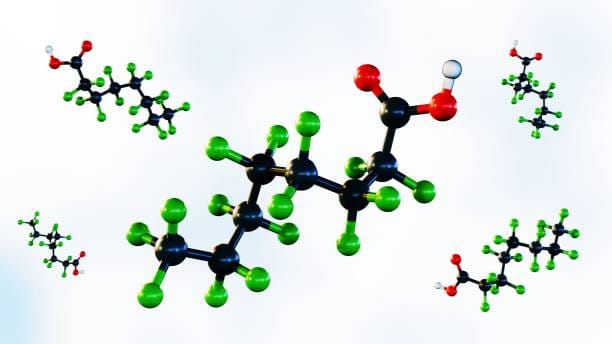The Chemistry of PFAS: "Forever Chemicals"

You’ve probably heard the term forever chemicals thrown around in the news, especially when it comes to water pollution and public health. What they’re referring to are PFAS, or per- and polyfluoroalkyl substances.
These synthetic compounds have been used in industry and consumer products for decades, but research has uncovered that they are harmful environmental headaches unlikely to naturally decompose anytime soon.
In this post, we’ll look at what PFAS are from a chemical standpoint, where they’re used in the real world, and why their persistence is a serious problem.
What Makes PFAS So Stable?
At the molecular level, PFAS are built around chains of carbon atoms that are fully or partially bonded to fluorine atoms. The carbon-fluorine bond is incredibly strong; this is the core reason they don’t degrade easily in the environment.
Fluorine's high electronegativity and the strength of the C–F bond make PFAS extremely stable. They're resistant to heat, acids, bases, oxidation, and just about any condition that would normally break down organic molecules. As a result, PFAS stays in soil, water, and living organisms for years or even decades.
There are many subclasses of PFAS, but the most well-known are the perfluoroalkyl acids like PFOA (perfluorooctanoic acid) and PFOS (perfluorooctane sulfonic acid), which are being widely studied for their environmental and health effects.
Where Do We Use PFAS and Why?
Despite their bad reputation, PFAS have some useful properties and have been widely used since the 1940s. Their stability and surface-active nature make them valuable in a range of applications:
- Firefighting foams: Aqueous film-forming foams (AFFF) rely on PFAS to quickly suppress oil and fuel fires. These foams have saved lives, especially in aviation and military settings, but they’ve also contaminated groundwater around training sites and airports.
- Medical devices: Fluorinated polymers have been used in manufacturing catheters, stents, and surgical tools because they’re chemically inert and biocompatible.
- Semiconductor manufacturing: The production of microchips and circuit boards involves harsh chemicals and precise processes. PFAS are used because they can handle extreme conditions without breaking down or interfering with delicate operations.
- Consumer products: PFAS are added to clothing, carpets, food packaging, and nonstick cookware for their ability to repel oil and water. If something is stain-resistant or waterproof, there’s a good chance PFAS are involved.
Why Is Everyone So Worried About Them?
The same qualities that make PFAS useful also make them a long-term problem. In the environment, they build up in ecosystems, in drinking water, and in the human body. Because PFAS can accumulate over time, even low exposures can eventually lead to significant levels in blood and tissues.
Long-term exposure to PFAS is associated with a range of health concerns, including immune system effects, thyroid disruption, reproductive issues, and some cancers. While not all PFAS have been thoroughly studied, the data we do have is enough to cause concern, especially for compounds like PFOA and PFOS, which have been phased out in many countries (and then replaced with less restricted PFAS).
That has led to a growing interest in how to decompose PFAS safely and efficiently. Proposed methods include advanced oxidation methods, high-temperature incineration, electrochemical degradation, and even plasma-based techniques. Some of these show promise in lab settings, but they’re often expensive, energy-intensive, and/or or difficult to scale.
So, What Comes Next?
The chemistry community is now facing a big challenge: how do we design fluorinated compounds that perform well without sticking around forever? Some researchers are working on short-chain PFAS that break down more easily; others are trying to develop surfactants with built-in chemical “off switches” that make them degradable after use or reaction.
For graduate students, this is an area ripe for innovation. PFAS research spans synthesis, environmental analysis, catalysis, materials science, and public policy. It’s a powerful example of how molecular design choices can have long-term consequences and why chemists need to think about the life cycle of what we create.
Thanks for reading!
Feel free to contact Chemistry Weekly at ChemistryWeeklyNews@gmail.com with any questions or comments.
Disclosure
The information above is based on my own beliefs, opinion and experiences. In no way does this blog represent or reflect the schools I have been to or the companies that I work and/or have worked for. I am not responsible or liable for any events that occur as a result of this information.
I am not affiliated with any of the companies mentioned above.